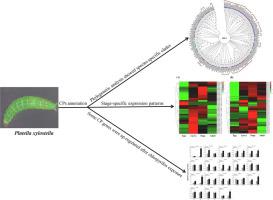Pesticide Biochemistry and Physiology ( IF 4.7 ) Pub Date : 2021-07-30 , DOI: 10.1016/j.pestbp.2021.104943 Er-Hu Chen 1 , Qiu-Li Hou 2

|
Structural cuticular proteins (CPs) are major components of the insect cuticle, and they play critical roles in insect development and insecticide resistance. Here, a total of 196 CP genes were successfully annotated in the Plutella xylostella genome. On the basis of motif analysis, these CPs were classified into 10 different families, including 122 CPR, 12 CPAP1, 8 CPAP3, 9 CPLCP, 2 Tweedle, 1 CPF, 1 CPFL, 1 CPCFC, 17 CPG and 2 18 aa proteins, and the remaining 21 unclassified CPs were classed as cuticular proteins hypothetical (CPH). A phylogenetic analysis of CPs from different insects revealed species-specific clades of RR-1 and RR-2 genes, suggesting that CP gene duplication might occur independently among insect taxa, while we also found that some other CPs (such as CPAP1 and CPAP3) had a closer relationship based on their conserved domain architecture. Using available RNAseq libraries, the expression profiles of the CPs were analyzed over the four developmental stages of the insect (i.e., egg, larva, pupa, and adult), revealing stage-specific expression patterns for the CPs. In a chlorpyrifos resistant strain, 18 CP genes were found to be more than two-fold upregulated compared to the susceptible control strain, and qRT-PCR analysis showed that these CP genes were overexpressed after exposure to chlorpyrifos, suggesting a potential role in the molecular mechanism of insecticide resistance in P. xylostella. This study provides the tools and molecular basis to study the role of CPs in the post-embryonal development and the mechanisms of insecticide resistance of P. xylostella.
中文翻译:

小菜蛾 Plutella xylostella (Lepidoptera: Plutellidae) 表皮蛋白基因的鉴定及表达分析
结构表皮蛋白 (CPs) 是昆虫角质层的主要成分,它们在昆虫发育和杀虫剂抗性中起着关键作用。在这里,共成功注释了Plutella xylostella 中的 196 个 CP 基因基因组。在基序分析的基础上,这些 CP 被分为 10 个不同的家族,包括 122 CPR、12 CPAP1、8 CPAP3、9 CPLCP、2 Tweedle、1 CPF、1 CPFL、1 CPCFC、17 CPG 和 2 18 aa 蛋白质,和其余 21 个未分类的 CP 被归类为假设的角质层蛋白 (CPH)。对来自不同昆虫的 CP 的系统发育分析揭示了 RR-1 和 RR-2 基因的物种特异性进化枝,表明 CP 基因重复可能在昆虫类群中独立发生,同时我们还发现一些其他 CP(如 CPAP1 和 CPAP3)基于它们保守的域架构有更密切的关系。使用可用的 RNAseq 文库,在昆虫的四个发育阶段(即卵、幼虫、蛹和成虫)分析了 CP 的表达谱,揭示了 CP 的阶段特异性表达模式。小菜蛾。本研究为研究小菜蛾胚胎后发育中CPs的作用及小菜蛾抗药性机制提供了工具和分子基础。



























 京公网安备 11010802027423号
京公网安备 11010802027423号